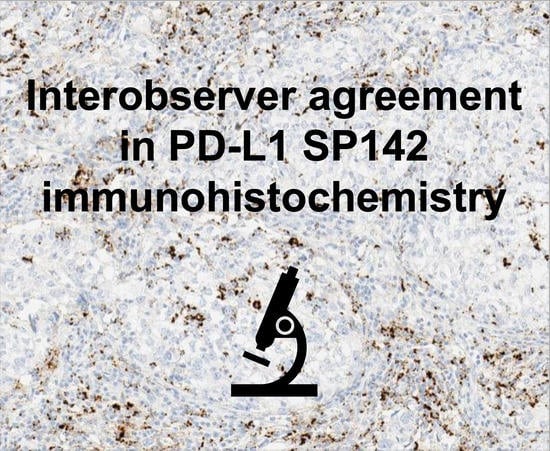Interobserver Agreement of PD-L1/SP142 Immunohistochemistry and Tumor-Infiltrating Lymphocytes (TILs) in Distant Metastases of Triple-Negative Breast Cancer: A Proof-of-Concept Study. A Report on Behalf of the International Immuno-Oncology Biomarker Working Group
Abstract
:Simple Summary
Abstract
1. Introduction
2. Materials and Methods
2.1. PD-L1/SP142 Proficiency Test
2.2. Specimens in the Study Set & Slide Scanning
2.3. TILs Assessment
2.4. PD-L1/SP142 Immunohistochemistry
2.5. Statistical Analysis
3. Results
3.1. Composition of the Proficiency Set and Study Set
3.2. Interobserver Agreement for PD-L1 Assessment in the Proficiency Set
3.3. Interobserver Agreement for PD-L1 Assessment in the Study Set
3.4. Interobserver Agreement for TILs Assment in the Study Set
3.5. Exploratory Analysis of Different Thresholds for TILs and PD-L1 Assessment
3.6. Associations between Metastatic Location, PD-L1 and TILs Assessment in the Study Set
3.7. Combined Evaluation of Dichotomous PD-L1 and TILs Assessment in the Study Set
4. Discussion
5. Conclusions
Supplementary Materials
Author Contributions
Funding
Institutional Review Board Statement
Informed Consent Statement
Data Availability Statement
Acknowledgments
Conflicts of Interest
References
- Thike, A.A.; Cheok, P.Y.; Jara-Lazaro, A.R.; Tan, B.; Tan, P.; Tan, P.H. Triple-negative breast cancer: Clinicopathological characteristics and relationship with basal-like breast cancer. Mod. Pathol. 2010, 23, 123–133. [Google Scholar] [CrossRef] [PubMed] [Green Version]
- van Maaren, M.C.; de Munck, L.; Strobbe, L.J.A.; Sonke, G.S.; Westenend, P.J.; Smidt, M.L.; Poortmans, P.M.P.; Siesling, S. Ten-year recurrence rates for breast cancer subtypes in the Netherlands: A large population-based study. Int. J. Cancer 2019, 144, 263–272. [Google Scholar] [CrossRef] [Green Version]
- Acheampong, T.; Kehm, R.D.; Terry, M.B.; Argov, E.L.; Tehranifar, P. Incidence Trends of Breast Cancer Molecular Subtypes by Age and Race/Ethnicity in the US From 2010 to 2016. JAMA Netw. Open 2020, 3, e2013226. [Google Scholar] [CrossRef]
- Howlader, N.; Cronin, K.A.; Kurian, A.W.; Andridge, R. Differences in breast cancer survival by molecular subtypes in the United States. Cancer Epidemiol. Biomark. Prev. 2018, 27, 619–626. [Google Scholar] [CrossRef] [PubMed] [Green Version]
- Dodson, A.; Parry, S.; Ibrahim, M.; Bartlett, J.M.S.; Pinder, S.; Dowsett, M.; Miller, K. Breast cancer biomarkers in clinical testing: Analysis of a UK national external quality assessment scheme for immunocytochemistry and in situ hybridisation database containing results from 199,300 patients. J. Pathol. Clin. Res. 2018, 4, 262–273. [Google Scholar] [CrossRef] [PubMed]
- Planes-Laine, G.; Rochigneux, P.; Bertucci, F.; Chrétien, A.S.; Viens, P.; Sabatier, R.; Gonçalves, A. PD-1/PD-l1 targeting in breast cancer: The first clinical evidences are emerging. a literature review. Cancers 2019, 11, 1033. [Google Scholar] [CrossRef] [Green Version]
- Gong, Y.; Liu, Y.R.; Ji, P.; Hu, X.; Shao, Z.M. Impact of molecular subtypes on metastatic breast cancer patients: A SEER population-based study. Sci. Rep. 2017, 7, 45411. [Google Scholar] [CrossRef] [Green Version]
- Loibl, S.; O’Shaughnessy, J.; Untch, M.; Sikov, W.M.; Rugo, H.S.; McKee, M.D.; Huober, J.; Golshan, M.; von Minckwitz, G.; Maag, D.; et al. Addition of the PARP inhibitor veliparib plus carboplatin or carboplatin alone to standard neoadjuvant chemotherapy in triple-negative breast cancer (BrighTNess): A randomised, phase 3 trial. Lancet Oncol. 2018, 19, 497–509. [Google Scholar] [CrossRef]
- Fasching, P.A.; Link, T.; Hauke, J.; Seither, F.; Jackisch, C.; Klare, P.; Schmatloch, S.; Hanusch, C.; Huober, J.; Stefek, A.; et al. Neoadjuvant paclitaxel/olaparib in comparison to paclitaxel/carboplatinum in patients with HER2-negative breast cancer and homologous recombination deficiency (GeparOLA study). Ann. Oncol. 2021, 32, 49–57. [Google Scholar] [CrossRef]
- Schmid, P.; Cortes, J.; Pusztai, L.; McArthur, H.; Kümmel, S.; Bergh, J.; Denkert, C.; Park, Y.H.; Hui, R.; Harbeck, N.; et al. Pembrolizumab for Early Triple-Negative Breast Cancer. N. Engl. J. Med. 2020, 382, 810–821. [Google Scholar] [CrossRef]
- Foldi, J.; Silber, A.; Reisenbichler, E.; Singh, K.; Fischbach, N.; Persico, J.; Adelson, K.; Katoch, A.; Horowitz, N.; Lannin, D.; et al. Neoadjuvant durvalumab plus weekly nab-paclitaxel and dose-dense doxorubicin/cyclophosphamide in triple-negative breast cancer. NPJ Breast Cancer 2021, 7, 9. [Google Scholar] [CrossRef] [PubMed]
- Voorwerk, L.; Slagter, M.; Horlings, H.M.; Sikorska, K.; van de Vijver, K.K.; de Maaker, M.; Nederlof, I.; Kluin, R.J.C.; Warren, S.; Ong, S.; et al. Immune induction strategies in metastatic triple-negative breast cancer to enhance the sensitivity to PD-1 blockade: The TONIC trial. Nat. Med. 2019, 25, 920–928. [Google Scholar] [CrossRef] [PubMed]
- Emens, L.A.; Molinero, L.; Loi, S.; Rugo, H.S.; Schneeweiss, A.; Diéras, V.; Iwata, H.; Barrios, C.H.; Nechaeva, M.; Nguyen-Duc, A.; et al. Atezolizumab and nab-Paclitaxel in Advanced Triple-Negative Breast Cancer: Biomarker Evaluation of the IMpassion130 Study. JNCI J. Natl. Cancer Inst. 2021, 113, 1005–1016. [Google Scholar] [CrossRef] [PubMed]
- Cortes, J.; Cescon, D.W.; Rugo, H.S.; Nowecki, Z.; Im, S.A.; Yusof, M.M.; Gallardo, C.; Lipatov, O.; Barrios, C.H.; Holgado, E.; et al. Pembrolizumab plus chemotherapy vs. placebo plus chemotherapy for previously untreated locally recurrent inoperable or metastatic triple-negative breast cancer (KEYNOTE-355): A randomised, placebo-controlled, double-blind, phase 3 clinical trial. Lancet 2020, 396, 1817–1828. [Google Scholar] [CrossRef]
- Vennapusa, B.; Baker, B.; Kowanetz, M.; Boone, J.; Menzl, I.; Bruey, J.M.; Fine, G.; Mariathasan, S.; McCaffery, I.; Mocci, S.; et al. Development of a PD-L1 Complementary Diagnostic Immunohistochemistry Assay (SP142) for Atezolizumab. Appl. Immunohistochem. Mol. Morphol. 2019, 27, 92–100. [Google Scholar] [CrossRef]
- Mediratta, K.; El-Sahli, S.; D’costa, V.; Wang, L. Current progresses and challenges of immunotherapy in triple-negative breast cancer. Cancers 2020, 12, 3529. [Google Scholar] [CrossRef]
- Schats, K.A.; Van Vré, E.A.; Boeckx, C.; De Bie, M.; Schrijvers, D.M.; Neyns, B.; De Meester, I.; Kockx, M.M. Optimal evaluation of programmed death ligand-1 on tumor cells vs. immune cells requires different detection methods. Arch. Pathol. Lab. Med. 2018, 142, 982–991. [Google Scholar] [CrossRef]
- Lawson, N.L.; Dix, C.I.; Scorer, P.W.; Stubbs, C.J.; Wong, E.; Hutchinson, L.; McCall, E.J.; Schimpl, M.; DeVries, E.; Walker, J.; et al. Mapping the binding sites of antibodies utilized in programmed cell death ligand-1 predictive immunohistochemical assays for use with immuno-oncology therapies. Mod. Pathol. 2020, 33, 518–530. [Google Scholar] [CrossRef] [Green Version]
- Gonzalez-Ericsson, P.I.; Stovgaard, E.S.; Sua, L.F.; Reisenbichler, E.; Kos, Z.; Carter, J.M.; Michiels, S.; Le Quesne, J.; Nielsen, T.O.; Laenkholm, A.V.; et al. The path to a better biomarker: Application of a risk management framework for the implementation of PD-L1 and TILs as immuno-oncology biomarkers in breast cancer clinical trials and daily practice. J. Pathol. 2020, 250, 667–684. [Google Scholar] [CrossRef] [Green Version]
- Emens, L.A.; Cruz, C.; Eder, J.P.; Braiteh, F.; Chung, C.; Tolaney, S.M.; Kuter, I.; Nanda, R.; Cassier, P.A.; Delord, J.P.; et al. Long-term Clinical Outcomes and Biomarker Analyses of Atezolizumab Therapy for Patients with Metastatic Triple-Negative Breast Cancer: A Phase 1 Study. JAMA Oncol. 2019, 5, 74–82. [Google Scholar] [CrossRef]
- Li, Y.; Vennapusa, B.; Chang, C.W.; Tran, D.; Nakamura, R.; Sumiyoshi, T.; Hegde, P.; Molinero, L. Prevalence Study of PD-L1 SP142 Assay in Metastatic Triple-negative Breast Cancer. Appl. Immunohistochem. Mol. Morphol. 2020, 29, 258–264. [Google Scholar] [CrossRef]
- Reisenbichler, E.S.; Han, G.; Bellizzi, A.; Bossuyt, V.; Brock, J.; Cole, K.; Fadare, O.; Hameed, O.; Hanley, K.; Harrison, B.T.; et al. Prospective multi-institutional evaluation of pathologist assessment of PD-L1 assays for patient selection in triple negative breast cancer. Mod. Pathol. 2020, 33, 1746–1752. [Google Scholar] [CrossRef]
- Hoda, R.S.; Brogi, E.; D’Alfonso, T.M.; Grabenstetter, A.; Giri, D.; Hanna, M.G.; Kuba, M.G.; Murray, M.P.; Vallejo, C.E.; Zhang, H.; et al. Interobserver Variation of PD-L1 SP142 Immunohistochemistry Interpretation in Breast Carcinoma: A Study of 79 Cases Using Whole Slide Imaging. Arch. Pathol. Lab. Med. 2021, 145, 1132–1137. [Google Scholar] [CrossRef]
- Tannock, I.F. Have investigators forgotten how to write? Ann. Oncol. 2021, 32, 437–438. [Google Scholar] [CrossRef]
- Fundytus, A.; Booth, C.M.; Tannock, I.F. How low can you go? PD-L1 expression as a biomarker in trials of cancer immunotherapy. Ann. Oncol. 2021, 32, 833–836. [Google Scholar] [CrossRef]
- Rugo, H.S.; Loi, S.; Adams, S.; Schmid, P.; Schneeweiss, A.; Barrios, C.H.; Iwata, H.; Dieras, V.C.; Winer, E.P.; Kockx, M.; et al. Performance of PD-L1 immunohistochemistry (IHC) assays in unresectable locally advanced or metastatic triple-negative breast cancer (mTNBC): Post-hoc analysis of IMpassion130. Ann. Oncol. 2019, 30, v851–v934. [Google Scholar] [CrossRef]
- Szekely, B.; Bossuyt, V.; Li, X.; Wali, V.B.; Patwardhan, G.A.; Frederick, C.; Silber, A.; Park, T.; Harigopal, M.; Pelekanou, V.; et al. Immunological differences between primary and metastatic breast cancer. Ann. Oncol. 2018, 29, 2232–2239. [Google Scholar] [CrossRef] [PubMed]
- NABON. Factsheet Indicatoren NABON Breast Cancer Audit (NBCA). 2017. Available online: https://www.nabon.nl/ (accessed on 29 March 2020).
- Wolff, A.C.; Hammond, M.E.H.; Allison, K.H.; Harvey, B.E.; Mangu, P.B.; Bartlett, J.M.S.; Bilous, M.; Ellis, I.O.; Fitzgibbons, P.; Hanna, W.; et al. Human Epidermal Growth Factor Receptor 2 Testing in Breast Cancer: American Society of Clinical Oncology/College of American Pathologists Clinical Practice Guideline Focused Update. J. Clin. Oncol. 2018, 36, 2105–2122. [Google Scholar] [CrossRef] [PubMed] [Green Version]
- FEDERA. Human Tissue and Medical Research: Code of Conduct for Responsible Use 2011. Available online: https://www.federa.org/codes-conduct (accessed on 29 March 2021).
- Agahozo, M.C.; Sieuwerts, A.M.; Charlane Doebar, S.; Verhoef, E.I.; Beaufort, C.M.; Ruigrok-Ritstier, K.; de Weerd, V.; Sleddens, H.F.B.M.; Dinjens, V.N.M.; Martens, J.W.M.; et al. PIK3CA mutations in ductal carcinoma in situ and adjacent invasive breast cancer. Endocr. Relat. Cancer 2019, 26, 471–482. [Google Scholar] [CrossRef] [PubMed]
- Salgado, R.; Denkert, C.; Demaria, S.; Sirtaine, N.; Klauschen, F.; Pruneri, G.; Wienert, S.; Van den Eynden, G.; Baehner, F.L.; Penault-Llorca, F.; et al. The evaluation of tumor-infiltrating lymphocytes (TILs) in breast cancer: Recommendations by an International TILs Working Group 2014. Ann. Oncol. 2015, 26, 259–271. [Google Scholar] [CrossRef]
- Hendry, S.; Salgado, R.; Gevaert, T.; Russell, P.A.; John, T.; Thapa, B.; Christie, M.; van de Vijver, K.; Estrada, M.V.; Gonzalez-Ericsson, P.I.; et al. Assessing Tumor-infiltrating Lymphocytes in Solid Tumors: A Practical Review for Pathologists and Proposal for a Standardized Method From the International Immunooncology Biomarkers Working Group: Part 1: Assessing the Host Immune Response, TILs in Invasi. Adv. Anat. Pathol. 2017, 24, 235–251. [Google Scholar] [CrossRef] [PubMed] [Green Version]
- Koo, T.K.; Li, M.Y. A Guideline of Selecting and Reporting Intraclass Correlation Coefficients for Reliability Research. J. Chiropr. Med. 2016, 15, 155–163. [Google Scholar] [CrossRef] [PubMed] [Green Version]
- Popovic, Z.B.; Thomas, J.D. Assessing observer variability: A user’s guide. Cardiovasc. Diagn. Ther. 2017, 7, 317–324. [Google Scholar] [CrossRef] [PubMed] [Green Version]
- Landis, J.R.; Koch, G.G. The Measurement of Observer Agreement for Categorical Data. Biometrics 1977, 33, 159–174. [Google Scholar] [CrossRef] [Green Version]
- Swisher, S.K.; Wu, Y.; Castaneda, C.A.; Lyons, G.R.; Yang, F.; Tapia, C.; Wang, X.; Casavilca, S.A.A.; Bassett, R.; Castillo, M.; et al. Interobserver Agreement Between Pathologists Assessing Tumor-Infiltrating Lymphocytes (TILs) in Breast Cancer Using Methodology Proposed by the International TILs Working Group. Ann. Surg. Oncol. 2016, 23, 2242–2248. [Google Scholar] [CrossRef] [PubMed]
- Van Bockstal, M.R.; Noel, F.; Guiot, Y.; Duhoux, F.P.; Mazzeo, F.; Van Marcke, C.; Fellah, L.; Ledoux, B.; Berlière, M.; Galant, C. Predictive markers for pathological complete response after neo-adjuvant chemotherapy in triple-negative breast cancer. Ann. Diagn. Pathol. 2020, 49, 151634. [Google Scholar] [CrossRef]
- O’Loughlin, M.; Andreu, X.; Bianchi, S.; Chemielik, E.; Cordoba, A.; Cserni, G.; Figueiredo, P.; Floris, G.; Foschini, M.P.; Heikkilä, P.; et al. Reproducibility and predictive value of scoring stromal tumour infiltrating lymphocytes in triple-negative breast cancer: A multi-institutional study. Breast Cancer Res. Treat. 2018, 171, 1–9. [Google Scholar] [CrossRef] [Green Version]
- Kos, Z.; Roblin, E.; Kim, R.S.; Michiels, S.; Gallas, B.D.; Chen, W.; van de Vijver, K.; Goel, S.; Adams, S.; Demaria, S.; et al. Pitfalls in assessing stromal tumor infiltrating lymphocytes (sTILs) in breast cancer. NPJ Breast Cancer 2020, 6, 17. [Google Scholar] [CrossRef]
- van Bockstal, M.R.; François, A.; Altinay, S.; Arnould, L.; Balkenhol, M.C.A.; Broeckx, G.; Burguès, O.; Colpaert, C.; Dedeurwaerdere, F.; Dessauvagie, B.; et al. Interobserver variability in the assessment of stromal tumor-infiltrating lymphocytes (sTILs) in triple-negative invasive breast carcinoma influences the association with pathological complete response: The IVITA study. Mod. Pathol 2021. Online ahead of print. [Google Scholar] [CrossRef]
- Floris, G.; Richard, F.; Hamy, A.S.; Jongen, L.; Wildiers, H.; Ardui, J.; Punie, K.; Smeets, A.; Berteloot, P.; Vergote, I.; et al. Body Mass Index and Tumor-Infiltrating Lymphocytes in Triple-Negative Breast Cancer. J. Natl. Cancer Inst. 2021, 113, 146–153. [Google Scholar] [CrossRef]
- Pang, J.-M.B.; Castles, B.; Byrne, D.J.; Button, P.; Hendry, S.; Lakhani, S.R.; Sivasubramaniam, V.; Cooper, W.A.; Armes, J.; Millar, E.K.A.; et al. SP142 PD-L1 Scoring Shows High Interobserver and Intraobserver Agreement in Triple-negative Breast Carcinoma But Overall Low Percentage Agreement With Other PD-L1 Clones SP263 and 22C3. Am. J. Surg. Pathol. 2021, 1–10, Publish Ahead online. [Google Scholar] [CrossRef]
- Kirkegaard, T.; Edwards, J.; Tovey, S.; McGlynn, L.M.; Krishna, S.N.; Mukherjee, R.; Tam, L.; Munro, A.F.; Dunne, B.; Bartlett, J.M.S. Observer variation in immunohistochemical analysis of protein expression, time for a change? Histopathology 2006, 48, 787–794. [Google Scholar] [CrossRef] [PubMed]
- Ahn, S.G.; Kim, S.K.; Shepherd, J.H.; Cha, Y.J.; Bae, S.J.; Kim, C.; Jeong, J.; Perou, C.M. Clinical and genomic assessment of PD-L1 SP142 expression in triple-negative breast cancer. Breast Cancer Res. Treat. 2021, 188, 165–178. [Google Scholar] [CrossRef] [PubMed]
- Amgad, M.; Stovgaard, E.S.; Balslev, E.; Thagaard, J.; Chen, W.; Dudgeon, S.; Sharma, A.; Kerner, J.K.; Denkert, C.; Yuan, Y.; et al. Report on computational assessment of Tumor Infiltrating Lymphocytes from the International Immuno-Oncology Biomarker Working Group. NPJ Breast Cancer 2020, 6, 16. [Google Scholar] [CrossRef] [PubMed]
- Ma, J.; Li, J.; Qian, M.; Han, W.; Tian, M.; Li, Z.; Wang, Z.; He, S.; Wu, K. PD-L1 expression and the prognostic significance in gastric cancer: A retrospective comparison of three PD-L1 antibody clones (SP142, 28–8 and E1L3N). Diagn. Pathol. 2018, 13, 91. [Google Scholar] [CrossRef] [PubMed]
- Schwamborn, K.; Ammann, J.U.; Knüchel, R.; Hartmann, A.; Baretton, G.; Lasitschka, F.; Schirmacher, P.; Braunschweig, T.; Tauber, R.; Erlmeier, F.; et al. Multicentric analytical comparability study of programmed death-ligand 1 expression on tumor-infiltrating immune cells and tumor cells in urothelial bladder cancer using four clinically developed immunohistochemistry assays. Virchows. Arch. 2019, 475, 599–608. [Google Scholar] [CrossRef] [Green Version]
- Sommer, U.; Eckstein, M.; Ammann, J.; Braunschweig, T.; Macher-Göppinger, S.; Schwamborn, K.; Hieke-Schulz, S.; Harlow, G.; Flores, M.; Wullich, B.; et al. Multicentric Analytical and Inter-observer Comparability of Four Clinically Developed Programmed Death-ligand 1 Immunohistochemistry Assays in Advanced Clear-cell Renal Cell Carcinoma. Clin. Genitourin. Cancer 2020, 18, e629–e642. [Google Scholar] [CrossRef] [Green Version]
- Wang, C.; Hahn, E.; Slodkowska, E.; Eskander, A.; Enepekides, D.; Higgins, K.; Vesprini, D.; Liu, S.K.; Downes, M.R.; Xu, B. Reproducibility of PD-L1 immunohistochemistry interpretation across various types of genitourinary and head/neck carcinomas, antibody clones, and tissue types. Hum. Pathol. 2018, 82, 131–139. [Google Scholar] [CrossRef]
- Downes, M.R.; Slodkowska, E.; Katabi, N.; Jungbluth, A.A.; Xu, B. Inter- and intraobserver agreement of programmed death ligand 1 scoring in head and neck squamous cell carcinoma, urothelial carcinoma and breast carcinoma. Histopathology 2020, 76, 191–200. [Google Scholar] [CrossRef]
- Shi, L.; Zhang, S.J.; Chen, J.; Lu, S.X.; Fan, X.J.; Tong, J.H.M.; Chow, C.; Tin, E.K.Y.; Chan, S.L.; Chong, C.C.N.; et al. A comparability study of immunohistochemical assays for PD-L1 expression in hepatocellular carcinoma. Mod. Pathol. 2019, 32, 1646–1656. [Google Scholar] [CrossRef]
- Bocanegra, A.; Fernandez-Hinojal, G.; Zuazo-Ibarra, M.; Arasanz, H.; Garcia-Granda, M.J.; Hernandez, C.; Ibanez, M.; Hernandez-Marin, B.; Martinez-Aguillo, M.; Lecumberri, M.J.; et al. PD-L1 expression in systemic immune cell populations as a potential predictive biomarker of responses to PD-L1/PD-1 blockade therapy in lung cancer. Int. J. Mol. Sci. 2019, 20, 1631. [Google Scholar] [CrossRef] [PubMed] [Green Version]
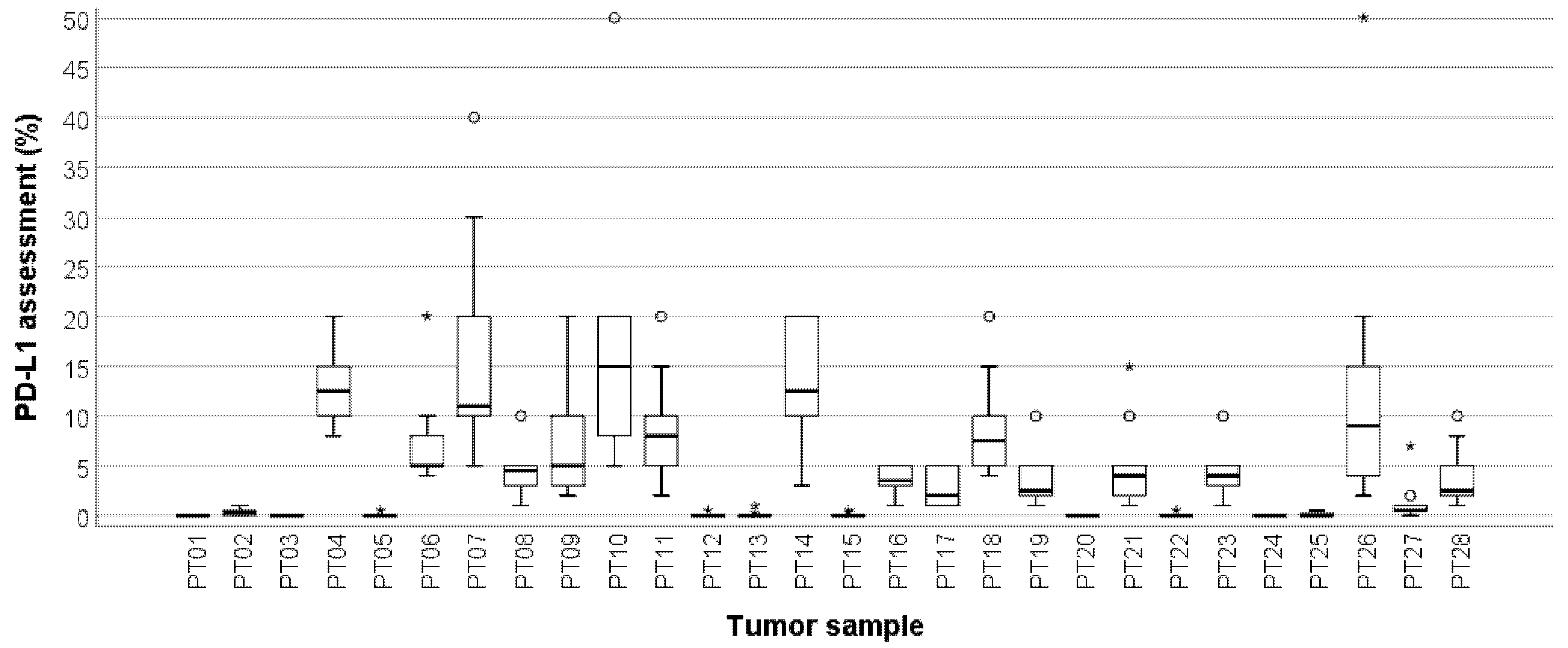

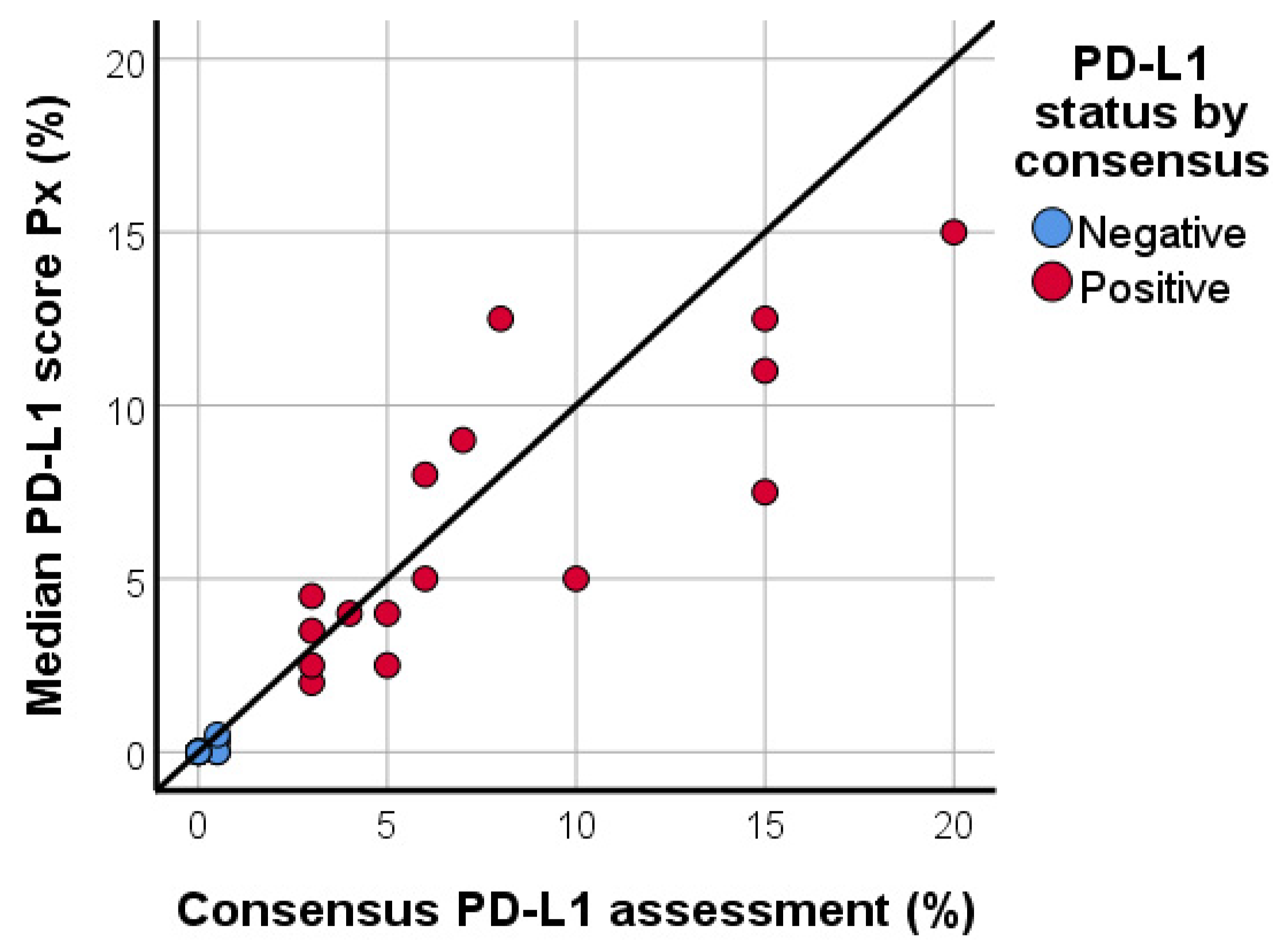
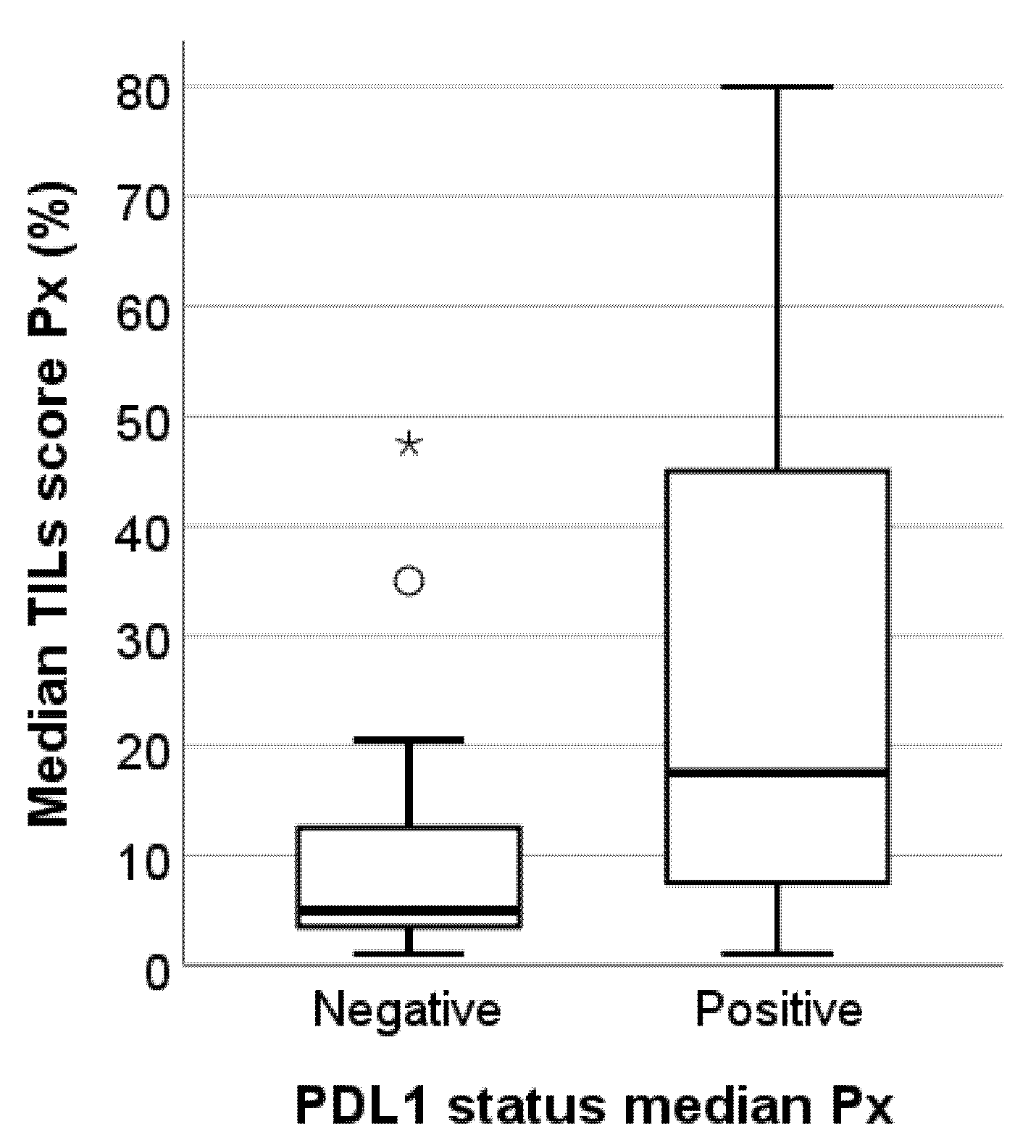
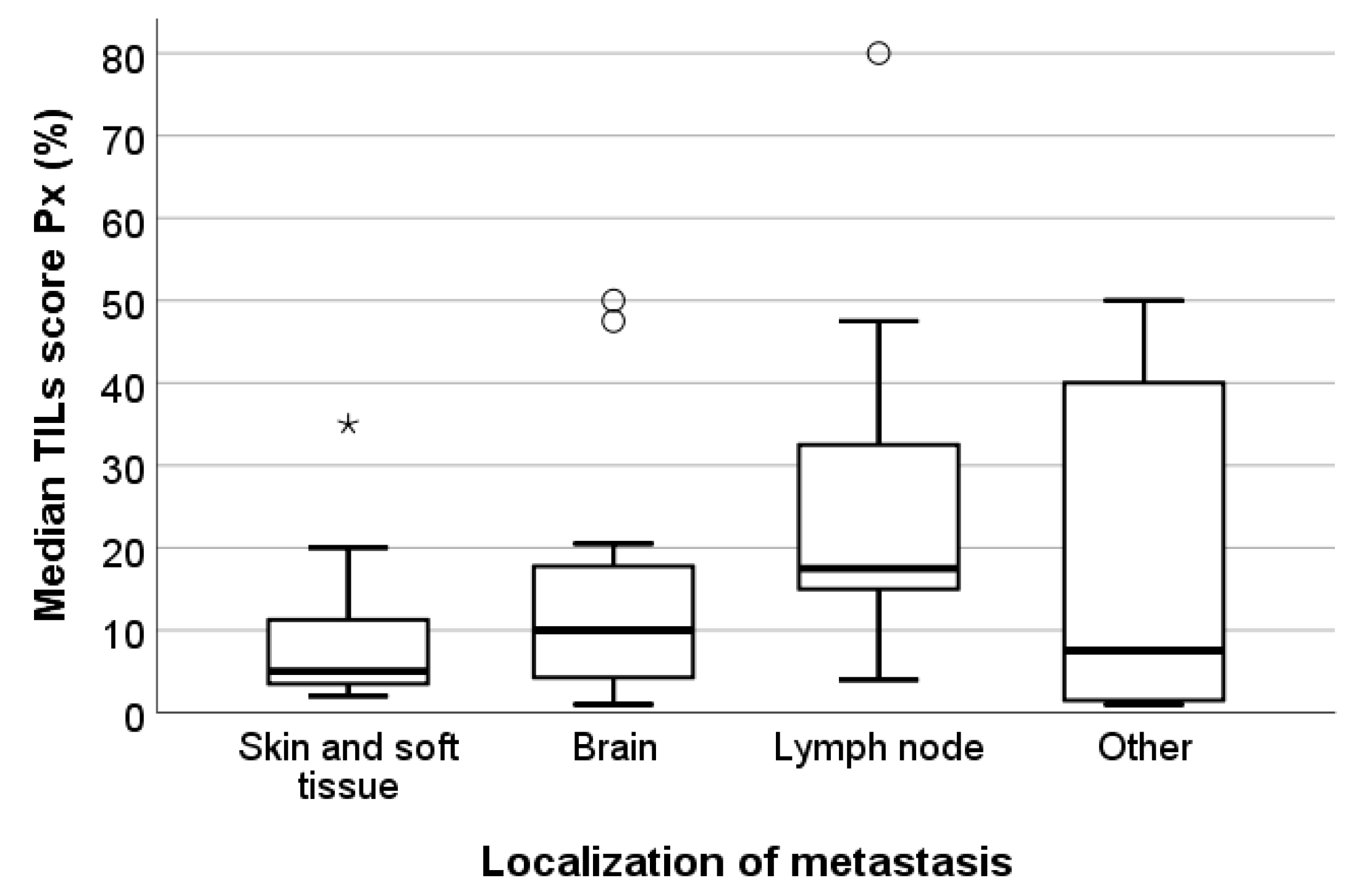

| PD-L1 Score (%) | PD-L1 P1 (%) | PD-L1 P2 (%) | PD-L1 P3 (%) | PD-L1 P4 (%) | PD-L1 P5 (%) | PD-L1 P6 (%) | PD-L1 P7 (%) | PD-L1 P8 (%) | PD-L1 P9 (%) | PD-L1 P10 (%) | PD-L1 Consensus (%) | Median PD-L1 Px (%) |
|---|---|---|---|---|---|---|---|---|---|---|---|---|
| PD-L1 P1 (%) | 1.000 | 0.826 | 0.458 | 0.773 | 0.779 | 0.826 | 0.775 | 0.616 | 0.766 | 0.563 | 0.764 | 0.805 |
| PD-L1 P2 (%) | 0.826 | 1.000 | 0.387 | 0.547 | 0.631 | 0.736 | 0.631 | 0.386 | 0.594 | 0.510 | 0.623 | 0.670 |
| PD-L1 P3 (%) | 0.458 | 0.387 | 1.000 | 0.798 | 0.631 | 0.684 | 0.602 | 0.611 | 0.812 | 0.837 | 0.826 | 0.835 |
| PD-L1 P4 (%) | 0.773 | 0.547 | 0.798 | 1.000 | 0.770 | 0.743 | 0.716 | 0.693 | 0.828 | 0.705 | 0.800 | 0.858 |
| PD-L1 P5 (%) | 0.779 | 0.631 | 0.631 | 0.770 | 1.000 | 0.785 | 0.766 | 0.793 | 0.793 | 0.744 | 0.786 | 0.909 |
| PD-L1 P6 (%) | 0.826 | 0.736 | 0.684 | 0.743 | 0.785 | 1.000 | 0.826 | 0.557 | 0.761 | 0.653 | 0.811 | 0.894 |
| PD-L1 P7 (%) | 0.775 | 0.631 | 0.602 | 0.716 | 0.766 | 0.826 | 1.000 | 0.652 | 0.738 | 0.596 | 0.793 | 0.823 |
| PD-L1 P8 (%) | 0.616 | 0.386 | 0.611 | 0.693 | 0.793 | 0.557 | 0.652 | 1.000 | 0.677 | 0.611 | 0.756 | 0.799 |
| PD-L1 P9 (%) | 0.766 | 0.594 | 0.812 | 0.828 | 0.793 | 0.761 | 0.738 | 0.677 | 1.000 | 0.922 | 0.858 | 0.914 |
| PD-L1 P10 (%) | 0.563 | 0.510 | 0.837 | 0.705 | 0.744 | 0.653 | 0.596 | 0.611 | 0.922 | 1.000 | 0.772 | 0.855 |
| PD-L1 Score (%) | P1 | P2 | P3 | P4 | P5 | P6 | P7 | P8 | P9 | P10 | Median Px |
|---|---|---|---|---|---|---|---|---|---|---|---|
| P1 | 1.000 | 0.723 | 0.593 | 0.681 | 0.167 | 0.511 | 0.534 | 0.726 | 0.702 | 0.559 | 0.766 |
| P2 | 0.723 | 1.000 | 0.766 | 0.706 | 0.432 | 0.693 | 0.713 | 0.809 | 0.868 | 0.746 | 0.917 |
| P3 | 0.593 | 0.766 | 1.000 | 0.693 | 0.268 | 0.984 | 0.831 | 0.713 | 0.893 | 0.944 | 0.928 |
| P4 | 0.681 | 0.706 | 0.693 | 1.000 | 0.438 | 0.662 | 0.715 | 0.649 | 0.699 | 0.661 | 0.771 |
| P5 | 0.167 | 0.432 | 0.268 | 0.438 | 1.000 | 0.210 | 0.480 | 0.271 | 0.200 | 0.195 | 0.336 |
| P6 | 0.511 | 0.693 | 0.984 | 0.662 | 0.210 | 1.000 | 0.823 | 0.676 | 0.848 | 0.938 | 0.880 |
| P7 | 0.534 | 0.713 | 0.831 | 0.715 | 0.480 | 0.823 | 1.000 | 0.717 | 0.642 | 0.674 | 0.788 |
| P8 | 0.726 | 0.809 | 0.713 | 0.649 | 0.271 | 0.676 | 0.717 | 1.000 | 0.703 | 0.624 | 0.775 |
| P9 | 0.702 | 0.868 | 0.893 | 0.699 | 0.200 | 0.848 | 0.642 | 0.703 | 1.000 | 0.940 | 0.951 |
| P10 | 0.559 | 0.746 | 0.944 | 0.661 | 0.195 | 0.938 | 0.674 | 0.624 | 0.940 | 1.000 | 0.905 |
| PD-L1 Status | P1 | P2 | P3 | P4 | P5 | P6 | P7 | P8 | P9 | P10 | Median Px |
|---|---|---|---|---|---|---|---|---|---|---|---|
| P1 | 1.000 | 0.620 | 0.762 | 0.704 | 0.559 | 0.776 | 0.500 | 0.535 | 0.952 | 0.507 | 0.866 |
| P2 | 0.620 | 1.000 | 0.547 | 0.673 | 0.550 | 0.508 | 0.633 | 0.510 | 0.547 | 0.590 | 0.672 |
| P3 | 0.762 | 0.547 | 1.000 | 0.630 | 0.481 | 0.604 | 0.514 | 0.383 | 0.712 | 0.692 | 0.780 |
| P4 | 0.704 | 0.673 | 0.630 | 1.000 | 0.632 | 0.754 | 0.633 | 0.510 | 0.630 | 0.672 | 0.836 |
| P5 | 0.559 | 0.550 | 0.481 | 0.632 | 1.000 | 0.455 | 0.593 | 0.386 | 0.481 | 0.623 | 0.707 |
| P6 | 0.776 | 0.508 | 0.604 | 0.754 | 0.455 | 1.000 | 0.471 | 0.426 | 0.692 | 0.578 | 0.662 |
| P7 | 0.500 | 0.633 | 0.514 | 0.633 | 0.593 | 0.471 | 1.000 | 0.633 | 0.514 | 0.553 | 0.634 |
| P8 | 0.535 | 0.510 | 0.383 | 0.510 | 0.386 | 0.426 | 0.633 | 1.000 | 0.547 | 0.263 | 0.590 |
| P9 | 0.952 | 0.547 | 0.712 | 0.630 | 0.481 | 0.692 | 0.514 | 0.547 | 1.000 | 0.429 | 0.780 |
| P10 | 0.507 | 0.590 | 0.692 | 0.672 | 0.623 | 0.578 | 0.553 | 0.263 | 0.429 | 1.000 | 0.662 |
| TILs Assessment (%) | P1 | P2 | P3 | P4 | P5 | P6 | P7 | P8 | P9 | P10 | Median Px (%) |
|---|---|---|---|---|---|---|---|---|---|---|---|
| P1 | 1.000 | 0.867 | 0.527 | 0.474 | 0.583 | 0.859 | 0.804 | 0.444 | 0.612 | 0.663 | 0.851 |
| P2 | 0.867 | 1.000 | 0.407 | 0.550 | 0.637 | 0.822 | 0.753 | 0.521 | 0.578 | 0.553 | 0.835 |
| P3 | 0.527 | 0.407 | 1.000 | 0.232 | 0.393 | 0.397 | 0.556 | 0.295 | 0.533 | 0.555 | 0.618 |
| P4 | 0.474 | 0.550 | 0.232 | 1.000 | 0.416 | 0.495 | 0.567 | 0.545 | 0.541 | 0.657 | 0.670 |
| P5 | 0.583 | 0.637 | 0.393 | 0.416 | 1.000 | 0.609 | 0.606 | 0.553 | 0.338 | 0.527 | 0.753 |
| P6 | 0.859 | 0.822 | 0.397 | 0.495 | 0.609 | 1.000 | 0.747 | 0.474 | 0.560 | 0.556 | 0.826 |
| P7 | 0.804 | 0.753 | 0.556 | 0.567 | 0.606 | 0.747 | 1.000 | 0.491 | 0.682 | 0.694 | 0.908 |
| P8 | 0.444 | 0.521 | 0.295 | 0.545 | 0.553 | 0.474 | 0.491 | 1.000 | 0.408 | 0.525 | 0.615 |
| P9 | 0.612 | 0.578 | 0.533 | 0.541 | 0.338 | 0.560 | 0.682 | 0.408 | 1.000 | 0.482 | 0.756 |
| P10 | 0.663 | 0.553 | 0.555 | 0.657 | 0.527 | 0.556 | 0.694 | 0.525 | 0.482 | 1.000 | 0.770 |
| Threshold for TILs Dichotomization | Concordance Rate for All Pairs of Pathologists Sample Mean ± Standard Deviation |
|---|---|
| TILs <5 vs. ≥5% | 0.734 (±0.042) |
| TILs <10 vs. ≥10% | 0.733 (±0.062) |
| TILs <30 vs. ≥30% | 0.797 (±0.067) |
| TILs <75 vs. ≥75% | 0.925 (±0.053) |
| Threshold for PD-L1 Dichotomization | Concordance Rate for All Pairs of Pathologists Sample Mean ± Standard Deviation | |
|---|---|---|
| Proficiency Set | Study Set | |
| PD-L1 <1 vs. ≥1% | 0.961 (±0.030) | 0.793 (±0.062) |
| PD-L1 <5 vs. ≥5% | 0.804 (±0.084) | 0.824 (±0.093) |
| PD-L1 <10 vs. ≥10% | 0.814 (±0.067) | 0.844 (±0.112) |
| Combined Biomarker | P1 | P2 | P3 | P4 | P5 | P6 | P7 | P8 | P9 | P10 |
|---|---|---|---|---|---|---|---|---|---|---|
| P1 | 1.000 | 0.613 | 0.852 | 0.718 | 0.511 | 0.719 | 0.355 | 0.548 | 0.791 | 0.641 |
| P2 | 0.613 | 1.000 | 0.623 | 0.788 | 0.506 | 0.461 | 0.508 | 0.546 | 0.493 | 0.580 |
| P3 | 0.852 | 0.623 | 1.000 | 0.724 | 0.435 | 0.632 | 0.371 | 0.468 | 0.733 | 0.745 |
| P4 | 0.718 | 0.788 | 0.724 | 1.000 | 0.439 | 0.645 | 0.449 | 0.564 | 0.573 | 0.674 |
| P5 | 0.511 | 0.506 | 0.435 | 0.439 | 1.000 | 0.448 | 0.671 | 0.371 | 0.468 | 0.563 |
| P6 | 0.719 | 0.461 | 0.632 | 0.645 | 0.448 | 1.000 | 0.378 | 0.399 | 0.570 | 0.580 |
| P7 | 0.355 | 0.508 | 0.371 | 0.449 | 0.671 | 0.378 | 1.000 | 0.546 | 0.493 | 0.580 |
| P8 | 0.548 | 0.546 | 0.468 | 0.564 | 0.371 | 0.399 | 0.546 | 1.000 | 0.500 | 0.509 |
| P9 | 0.791 | 0.493 | 0.733 | 0.573 | 0.468 | 0.570 | 0.493 | 0.500 | 1.000 | 0.780 |
| P10 | 0.641 | 0.580 | 0.745 | 0.674 | 0.563 | 0.580 | 0.580 | 0.509 | 0.780 | 1.000 |
Publisher’s Note: MDPI stays neutral with regard to jurisdictional claims in published maps and institutional affiliations. |
© 2021 by the authors. Licensee MDPI, Basel, Switzerland. This article is an open access article distributed under the terms and conditions of the Creative Commons Attribution (CC BY) license (https://creativecommons.org/licenses/by/4.0/).
Share and Cite
Van Bockstal, M.R.; Cooks, M.; Nederlof, I.; Brinkhuis, M.; Dutman, A.; Koopmans, M.; Kooreman, L.; van der Vegt, B.; Verhoog, L.; Vreuls, C.; et al. Interobserver Agreement of PD-L1/SP142 Immunohistochemistry and Tumor-Infiltrating Lymphocytes (TILs) in Distant Metastases of Triple-Negative Breast Cancer: A Proof-of-Concept Study. A Report on Behalf of the International Immuno-Oncology Biomarker Working Group. Cancers 2021, 13, 4910. https://doi.org/10.3390/cancers13194910
Van Bockstal MR, Cooks M, Nederlof I, Brinkhuis M, Dutman A, Koopmans M, Kooreman L, van der Vegt B, Verhoog L, Vreuls C, et al. Interobserver Agreement of PD-L1/SP142 Immunohistochemistry and Tumor-Infiltrating Lymphocytes (TILs) in Distant Metastases of Triple-Negative Breast Cancer: A Proof-of-Concept Study. A Report on Behalf of the International Immuno-Oncology Biomarker Working Group. Cancers. 2021; 13(19):4910. https://doi.org/10.3390/cancers13194910
Chicago/Turabian StyleVan Bockstal, Mieke R., Maxine Cooks, Iris Nederlof, Mariël Brinkhuis, Annemiek Dutman, Monique Koopmans, Loes Kooreman, Bert van der Vegt, Leon Verhoog, Celine Vreuls, and et al. 2021. "Interobserver Agreement of PD-L1/SP142 Immunohistochemistry and Tumor-Infiltrating Lymphocytes (TILs) in Distant Metastases of Triple-Negative Breast Cancer: A Proof-of-Concept Study. A Report on Behalf of the International Immuno-Oncology Biomarker Working Group" Cancers 13, no. 19: 4910. https://doi.org/10.3390/cancers13194910
APA StyleVan Bockstal, M. R., Cooks, M., Nederlof, I., Brinkhuis, M., Dutman, A., Koopmans, M., Kooreman, L., van der Vegt, B., Verhoog, L., Vreuls, C., Westenend, P., Kok, M., van Diest, P. J., Nauwelaers, I., Laudus, N., Denkert, C., Rimm, D., Siziopikou, K. P., Ely, S., ... van Deurzen, C. H. M. (2021). Interobserver Agreement of PD-L1/SP142 Immunohistochemistry and Tumor-Infiltrating Lymphocytes (TILs) in Distant Metastases of Triple-Negative Breast Cancer: A Proof-of-Concept Study. A Report on Behalf of the International Immuno-Oncology Biomarker Working Group. Cancers, 13(19), 4910. https://doi.org/10.3390/cancers13194910








